Written By: Dan Geer

Just as a preface, this list will not include simple dramas, comedies or musicals, but will instead focus on films in the science fiction, fantasy, action and horror genres from the last 40 years.
Many movies go underappreciated for any number of reasons. Sometimes we have favorites that the majority (or very vocal minority) do not seem to appreciate but are actually quite good. Other times films are just not really great per se, but perhaps better than people give them credit for. After all, even an average film can be entertaining and fun on multiple levels.
Whatever the reason, there are many films that are simply underrated or misunderstood, or have even been forgotten that deserve more appreciation that they commonly receive, whether by critics or the general movie-going public. The following list represents Popcorn Monster’s top 10 most underappreciated genre films of the last 40 years (click on the titles for trailers)…
10) Planet of the Apes (2001)
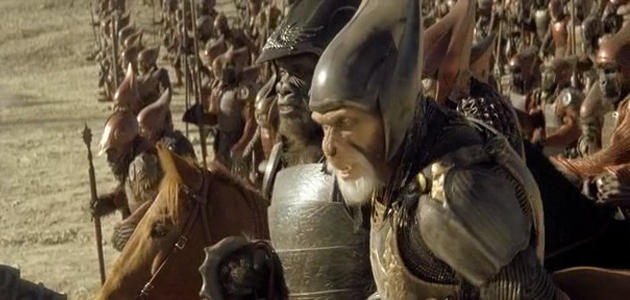
This film actually works for the most part, right up until the end. You can find decent explanations online that kind of explain some things, and even the DVD itself came with a nice timeline infographic laying it out. But the film itself needed to do this better for the audience, or at least clarify a bit more to help us understand. The way it ended up, it just looks like the final scene was tacked on at the last minute just to have a twist ending like the original 1968 film did. Maybe it was? I don’t know.
Whatever. The point is that the movie had quite a lot going for it up until it falls apart in the last several minutes. Aside from the fact that it is one of the few Tim Burton films not starring Johnny Depp – it is actually quite an entertaining film overall.
The action is top notch, with the end battle providing quite the spectacle. Rick Baker’s makeup work for the apes is outstanding – quite a few steps above the makeup in the original series. Lastly, the movie consists of a stellar cast, with Mark Wahlberg, Tim Roth, Michael Clarke Duncan, Paul Giamatta and Helena Bonham Carter (before she was in every Tim Burton movie). They give it their all here, and pull it off very well. Even Charlton Heston has a role, with him playing the father of the evil “Thade” (Tim Roth), issuing a variation of his famous “Damn you all to hell!” line from the original film. How can you not love that?!
Even if you disagree, it was probably this film that paved the way for the vastly superior rebooted series directed by Rupert Wyatt and Matt Reeves. So we at least have Tim Burton to thank for that anyway.
9) Godzilla (1998)
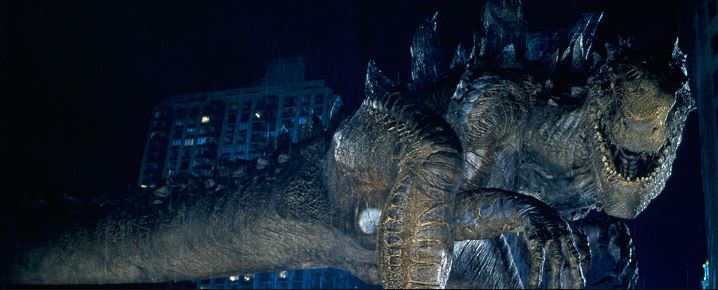
Absolutely abhorred by every Godzilla fan on the planet, director Roland Emmerich’s take on the King of the Monsters failed in delivering a movie that is truly reverent of the beloved giant gojirasaurus in almost every way. This is mainly due to the design of the monster, who does not resemble Godzilla visually, other than the fact that she is huge. It’s this weird mix of Iguana and T-Rex that is just off-putting for those that have grown fond of the iconic look of Godzilla that had been pretty much maintained for nearly half a century at that point.
However, this does not dismiss the fact that if you forget that it is a Godzilla movie, the film is actually a pretty fun giant monster movie. Not that it doesn’t have its own share of faults outside of not being reverential enough, but in terms of a giant dinosaur-like creature destroying cities and giving us likable characters – the film succeeds well enough. It is still not a great film, but to say it is completely terrible in every way is going too far I think.
8) Howard the Duck (1986)
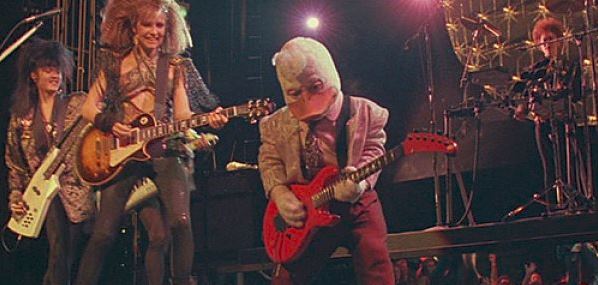
This is not a great movie, but I defy anyone not to have a blast watching this crazy duck fest. It is seriously one of the most bizarre stories produced by George Lucas. Tim Robbin’s character is pretty intolerable, but everything else about this is just pure 80s fluff that one cannot help but devour. It’s like that greasy bag of potato chips that you can’t stop eating. The film is very self-aware, embracing its over-the-top sense of humor from the beginning introduction right down to the last scene with Howard the Duck shreading on electric guitar with Cherry Bomb on stage in front of an exhilarated rock crowd.
Lea Thompson, who had just come off of the highly-successful Back to the Future the previous year, steps into the lead singer role of the band and actually performs the vocals herself. Even though people fault Thompson for going straight from one of the greatest movies of all time to one of the worst – we have to admit she was still great in every scene and gave exactly what the film called for. You can only ask so much from an actress when the role calls for you to fall in love with a talking duck. Speaking of falling in love with a talking duck, how uncomfortable is that love scene? Really glad the two were interrupted there.
And how can we forget the great Jeffrey Jones, who plays “Dr. Walter Jenning” and later gets possessed by the Dark Overlord? Even though it is a completely over-the-top performance, that character creeped me out as a kid the more and more deformed his face became, and that evil voice still gets me every time (even though I am now laughing instead of shuttering in fear). It’s just so ridiculous that I can’t help but enjoy the transformation.
Overall, this movie is pure gold, if only because it embraces what it is. It is pure weirdness, pure nonsense, and yet all 110 minutes grab me every time.
7) Masters of the Universe (1987)
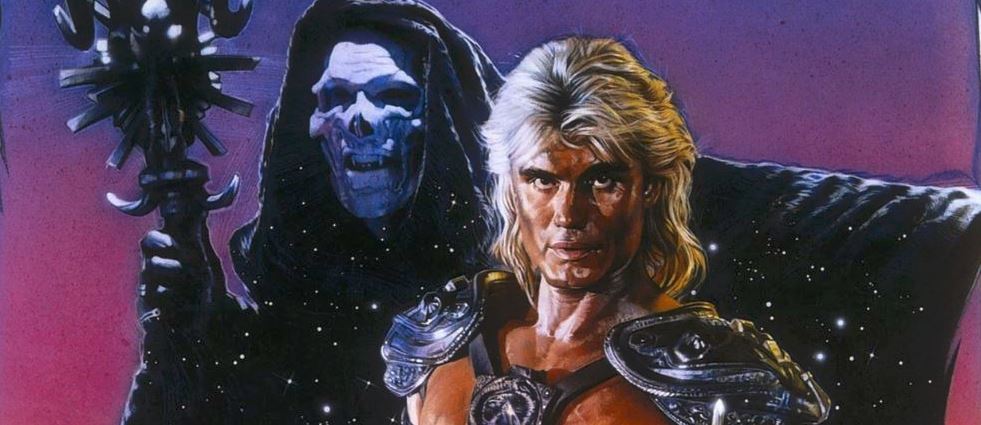
Okay, picture this: How do we take the popular He-Man animated series and make it work as a live-action film? Easy. First, for inspiration, we inhale a big huff of Star Wars, then exhale through a Beastmaster filter. After that, send “He-Man” to Earth to prevent the evil “Skeletor” and his minions from taking over the universe with a futuristic music keyboard… WHAT?!
That’s pretty much the premise of this movie. While it cannot really be considered a good movie by any means, the film actually makes this concept seem a lot better than it actually is. Sure, Dolph Lundgren doesn’t really have the acting chops to create a memorable live-action He-Man (to be fair, the animated version of the character isn’t any better). But Frank Langella really does a fantastic job as Skeletor. Seriously, he’s great in this movie. It doesn’t matter how bad some parts of the movie get, he always commands your attention, despite the lackluster material. That’s when you know you have a brilliant actor in your presence – when they can effortlessly turn garbage into gold.
This film does not do a very good job being reverent to the source material overall, although many concepts do make their way into the film here. Having said that, like the 1998 Godzilla, if you just forget that it’s a He-Man film, it actually holds your attention with a decent musical score, fine acting by Langella, and entertaining sci-fi action sequences throughout. He-Man on a hover-scooter shooting lasers? Genius. Also, it’s just hilarious to watch, right up through when Lundgren shouts “I HAVE THE POWER!!!” at the end. You’ll want to watch all over again right away.
This film is probably guilty pleasure material all the way, and I hold no shame in my enjoyment of it because it is still tons of fun. There are far worse ways to spend your time.
6) Halloween III: Season of the Witch (1982)
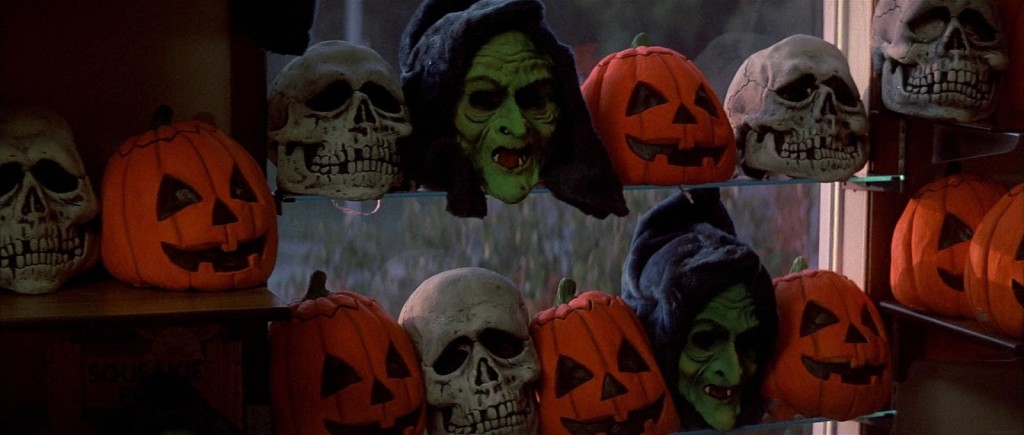
After already having two of John Carpenter’s Halloween films deal directly with “Michael Myers,” Halloween III: Season of the Witch really throws the audience for a loop. Why were we getting a film without Michael Myers? Sure, he seemed to be dead, but the film did not tie into the previous two in any way whatsoever, save for the first film being played in the background on a TV screen at a bar. Halloween III was completely outside of the timeline of what we had seen before, having nothing to do with the Myers story line.
However, the original intent of the Halloween series was to create a sort of anthology of stories that all took place on Halloween with each new film. When people realize this, suddenly they can look at Halloween III more objectively and judge the film on its own merits. It actually is a really great horror story, and quite scary on a number of levels. Evil androids? Halloween masks that can kill kids? A plot for mass murder? Sounds kind of all over the place, but it really is quite a dark and scary film, enjoyable on so many levels.
Of course, because of its initial reception, they found a way to bring Michael Myers back for every single Halloween film after that. To be honest, in hindsight the series kind of suffers for it (although there are some gems among the sequels). Imagine if we just got a wonderful standalone Halloween story with each film instead? Personally, I would prefer that over finding unrealistic ways to bring back Myers each time.
5) The Arrival (1996)
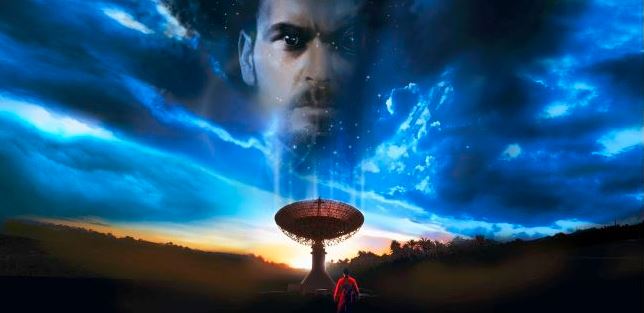
Back in 1996, when Independence Day took the world by storm and blew it up – another sci-fi alien flick already came and went two months prior that summer that barely made a dent at the box office that was actually quite good, even better in a lot of ways.
The Arrival (not to be confused with the more recent Amy Adams film Arrival), starred Charlie Sheen as a S.E.T.I. employee that discovers a signal from a distant star that ultimately leads Sheen’s character “Zane” on a thrilling chase across the globe, unraveling an alien plot to destroy humanity. The plot is in no way like Independence Day, with giant ships blowing up famous landmarks to annihilate mankind. It is actually more in the vein of Invasion of the Body Snatchers, which is awesome.
While not perfect, The Arrival is a highly entertaining sci-fi thriller, complete with conspiracy and other various points of intrigue that are sure to thrill any fan of science fiction. Highly underrated film.
4) The X-Files: I Want to Believe (2008)
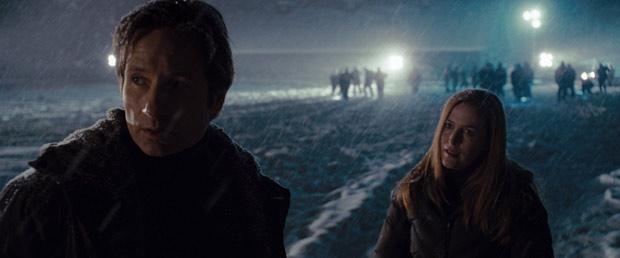
Ten years after the first X-Files feature film debuted, The X-Files: I Want to Believe took on the task of not only reintroducing us to the characters of “Mulder” and “Scully” after the series had been off the air for six years, but also telling a story worthy of the show’s legacy on a smaller budget of only $30 million. Not only that, but it debuted in the summer just one week after The Dark Knight crushed any sort of competition for the next few weekends. The X-Files didn’t stand a chance.
Having been a longtime fan of The X-Files TV series and first film, even I was initially disappointed in I Want to Believe. The first film had such an epic big-screen scale to it, containing a plot so vital to the ongoing mythology of the series, that it made this sequel feel so tiny and insignificant by comparison. It just didn’t pack the punch that I was expecting, which is why the disappointment set in so easily at first.
However, after re-watching the film at home, I had come to appreciate it much more with repeated viewings. It really plays more like an extended standalone episode of the show where Mulder and Scully aren’t investigating something paranormal or trying to unravel an alien conspiracy. Rather, this plays more like episodes such as “Beyond the Sea,” or “Irresistible,” where they are caught in the middle of something weird or grotesque. Not every episode of The X-Files relied on the paranormal, monsters or UFOs to drive the plot, and I Want to Believe reflects this type of story in spades.
The film is shot beautifully, with breathtaking wintery landscapes and high contrast lights and darks, and the story is actually quite thrilling if one simply accepts it for what it is. At its core, it’s a thriller comprised of the weird and unknown that also consists of great dramatic tension between the lead characters and their own personal journeys, shaking the very foundations of their relationship. It’s bittersweet, actually, especially knowing where the characters wind up in the season that follows (referred to as the “Event Series,” or “Season 10”). To put it simply, the film is haunting on every level.
Aside from debuting after The Dark Knight, the real problem is that this film is really not very fitting for the big screen. It just doesn’t have the spectacle or significance that the first film had. But that does not make I Want to Believe a bad movie on its own. Rather, it is just much easier to appreciate the film on the small screen, perhaps late in the evening on a Friday night like in the early day of the series. In that respect, this is totally an X-file, and I for one have come to love this movie the more I watch it.
3) The Final Cut (2004)
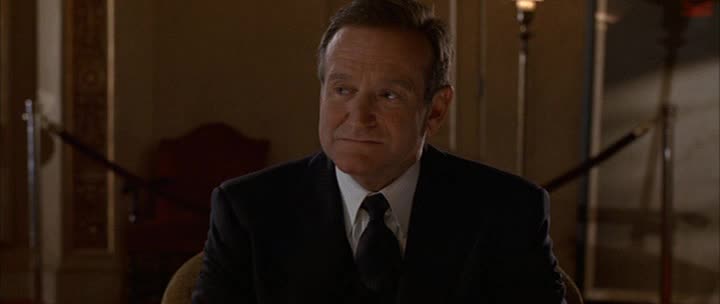
Back when Robin Williams was exploring other roles outside of comedy, the lead role in a little sci-fi film called The Final Cut was offered to him. Accepting the role, Williams takes us on a very insightful, and sometimes scary journey of what a world would look like if one’s memories could be recorded from birth through memory implants.
In this story, Williams plays “Alan Hackman,” a “cutter” – referring to a person employed by someone to cut together a video montage (complete with a sentimental music score) of the memories of one who has passed away, mainly to play at funerals.
The job raises all sorts of controversy. Hackman gets hired to cut together a video that portrays the person in the best light possible, but what about all the private memories that perhaps loved ones would like to forget, or erase literally as is the case here? Was the person really as great as the final cut portrays? After all, the unedited “rememory,” as the film calls it, shows everything – including a person’s most deepest, darkest secrets. It becomes very clear early on that Hackman gets paid not just to cut together montages, but also to sometimes keep quiet about various aspects of a life.
It also brings up issues of how one remembers things. There is a scene where a man present for a rememory viewing remarks about remembering a red fishing boat shown in the video as being green. Hackman responds by saying, “Maybe it was green,” proposing that even one’s perception could distort how he or she sees the world.
The Final Cut is a thinking person’s science-fiction film, and went largely unnoticed by the general public, consisting of a tight script filled with insightful thought and twists that are sure to captivate. Actor Jim Caviezel also plays a great antagonist in the film, which is a plus. In my opinion, it is far better than Rotten Tomatoes rates it, at least deserving of a 3.5-star rating (out of four).
2) Indiana Jones and the Kingdom of the Crystal Skull (2008)
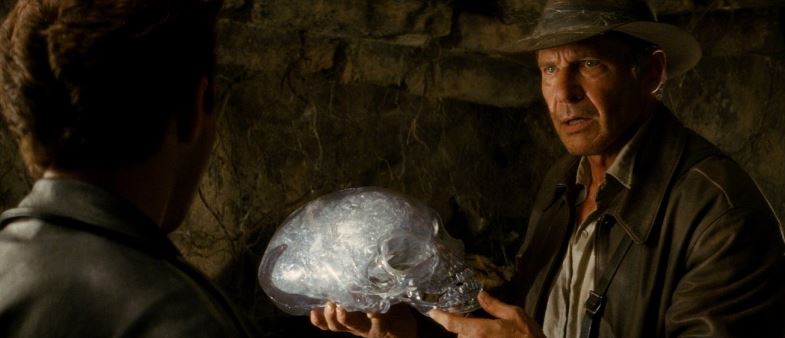
For a film that seems to have been fairly well-recieved by critics – the fans sure hate this movie. Not all, mind you, but it definitely divided the fanbase for sure. Aliens? CG monkeys? Tarzan stunts?! This movie had a lot in it that was just bizarre. One cannot help but wonder what the heck George Lucas was thinking with this one.
However, it had a lot going for it as well. First and foremost, Harrison Ford stepped back into the role of “Indiana Jones” after 19 years and pulled it off as if he never left. He really was great as a sort of “old man” Indy that grew into a personality not unlike his father from The Last Crusade. That right there was actually a brilliant move, in that he was still Indy, maintaining a snide sense of cockiness, but also older and wiser and perhaps not as daring as he used to be.
The rest of the cast is pretty great as well. Cate Blanchett plays Russian villain “Irina Spalko” quite effortlessly, and Karen Allen reprises the role of “Marion” from Raiders of the Lost Ark with the kind of charm she had all those years ago – but like Ford, a little older and wiser. Shia LaBeouf, despite being sort of an odd character in real life, his character “Mutt Williams” fared well enough. Ray Winstone’s “Mac” was probably the only character that was truly nauseating.
Crystal Skull appropriately ages the franchise to take place 19 years after the original, aligning with the passage of time in real life since The Last Crusade, setting the film in the late 1950s when the UFO craze was everywhere and flying saucer films debuted left and right. So it is very fitting to also introduce this phenomenon into the film. It also adheres to the Russian Cold War period in general quite well, highlighting the heightened fear and paranoia of the time.
Probably the biggest complaint of the film – other than Indy surviving the nuked fridge unscathed – was the fact that the plot consisted of “aliens.” However, the film does not call them “space aliens,” but rather “inter-dimensional beings” that were worshipped by the Ugha tribe for centuries. Not only does this introduce a religious aspect to the film, which is in the same vein as the previous films, but it also allows for the possibility that these beings are supernatural in and of themselves, just like any of the other gods we’ve seen Indiana Jones pursue.
It seems silly on the surface, but on some level it actually works – especially since we know they’re not from outer space, but rather “the space between spaces,” as John Hurt’s character “Harold Oxley” so eloquently puts it. If gods, angels or demons come from a different plane of existence than our own – then what makes these inter-dimensional beings any different? They could be from Hell for all we know. The film is just too ambiguous to say one way or another, and probably suffers because of that. But at least this leaves room for speculation that fits the parameters the film already establishes.
The first two acts are classic Indiana Jones, with high-speed car chases, glorious fist fights, and classic one-liners that are worthy of the franchise. The film is shot exactly like any other Indiana Jones movie, except that more CGI was used for effects, which was probably not the best choice. But overall, the film consisted of mostly practical effects, so the CGI used here was not all that distracting for me personally.
While Crystal Skull is certainly not the best in the series, it is a lot better than people give it credit for. It has its ups and downs, including stunts that seem far too incredible even for an Indiana Jones flick. But aside from those things, there’s a lot of good to be had as well. Over time, I think fans will come to revere it a bit more, similarly to how people grew more fond of Temple of Doom over time (it was not generally well-received at first).
1) Star Wars: Episode I – The Phantom Menace (1999)

Ah, yes. Yet another George Lucas movie that gets unjustly maligned by the masses (the poor man just can’t seem to get a break). It is to be expected. The more popular a franchise is, the higher the expectations get. The potential for mass rejection is just inherently far greater for movies like this.
The Phantom Menace really did have a lot to live up to. It was the first Star Wars film in 16 years, so it represented the first real return of the franchise after all that time. Expectation was probably greater for this movie than any Star Wars film since, and for pretty much any movie in the history of cinema.
It has aspects to it that are far different from what we had become accustomed to with the original trilogy. It was a different era, so things were shinier, less run down and perhaps “lighter” to some extent, since it was “before the dark times,” as Old Ben put it. It was before the Empire ever formed, so things were so complacent that the opening crawl can’t think of anything more exciting to talk about than the taxation of trade routes.
But this is just the MacGuffin. The film really represents not only the introduction of “Anakin Skywalker,” who would later become “Darth Vader,” but it also represents the very beginning of when things started playing in favor of the dark side via “Senator Palpatine.” As a Senator, the character played a vital political role as a top advisor for the Queen of his home planet, Naboo. But as a Sith (“Darth Sidious”), this same man invaded Naboo by manipulating the Trade Federation to do so. In short, he invaded his own home planet to gain sympathy in the Senate – a move that all but assured him that he would be the top nominee to replace “Chancellor Valorum” and rule the Galaxy.
Pretty brilliant move by the future Emperor if you ask me, and that awesome strategy is one of the main plot points of The Phantom Menace – a film that thousands of fans revile with such passion to this very day. Palpatine is the “phantom menace,” not “Darth Maul” as the marketing lead us to believe. This movie is just as much Palpatine’s as it is Anakin’s, and the subtlety to which his chess game is played was done so well that many overlooked it or just didn’t appreciate it for whatever reason. Of course it was difficult to appreciate it fully at first, with each subsequent film revealing more and more interesting maneuvers of his insidious plot (see what I did there?).
Most likely it is due to the more light-hearted and obviously dumb aspects to Episode I that George Lucas thought would be fun but ultimately turned everyone off except for 5-year olds. Kids love “Jar Jar Binks,” the fart and poop jokes, etc., but it really was a bit too juvenile for everyone else, even for a Star Wars movie. The film would’ve been better off without those things, and kids still would have loved it because of all the other adventurous aspects the movie has to offer.
In the end, the story of this film, as well Episodes II and III, really are fantastic. Not perfect, as I am sure some aspects could have, or even should have been executed differently. The acting and dialogue in particular lacked the passion and wittiness of the originals. But the story, breathtaking locales, exhilarating action (particularly the lightsaber battles and pod race) and musical score are all spectacular. “Duel of the Fates” is still one of the most memorable John Williams scores of all time. Even the model and miniature work, which is far more extensive than people seem to realize, is absolutely outstanding. There is a ton to love about this movie.
To this day, The Phantom Menace is by far the most underrated and underappreciated movie in film history. It’s a far cry from most of the other episodes in the franchise, but it is not a terrible film by any means. On its own merits, it is an above average film that got blasted by so many because of high expectation, constant comparison, and how widespread its viewership was at the time. Everyone and their mother went to see this movie in 1999, and when it was vastly different and more subtle than the other films, people just didn’t know what to make of it, other than to hate it because of the few lackluster aspects that stuck out in the forefront.
Over the last couple of decades, the film has gained more notoriety. I see more and more websites devoting time to highlighting the good from the Star Wars prequels. All three films in the prequel trilogy are still hated to this day by many, but as time has passed, more and more have started to appreciate them like they should. To call any of them “bad films” is a gross over-exaggeration. Perhaps a disappointment, but surely not terrible by any means.
Just mute all the Jar Jar scenes and you’ll be fine.
—
Notable Mentions:
The Black Hole (1979)
Dick Tracy (1990)
The Shadow (1994)
Bicentennial Man (1999)
The Thirteenth Floor (1999)
A.I. Artificial Intelligence (2001)
John Carter (2012)
The Age of Adaline (2015)
Batman v Superman: Dawn of Justice (Ultimate Edition) (2016)
The BFG (2016)









